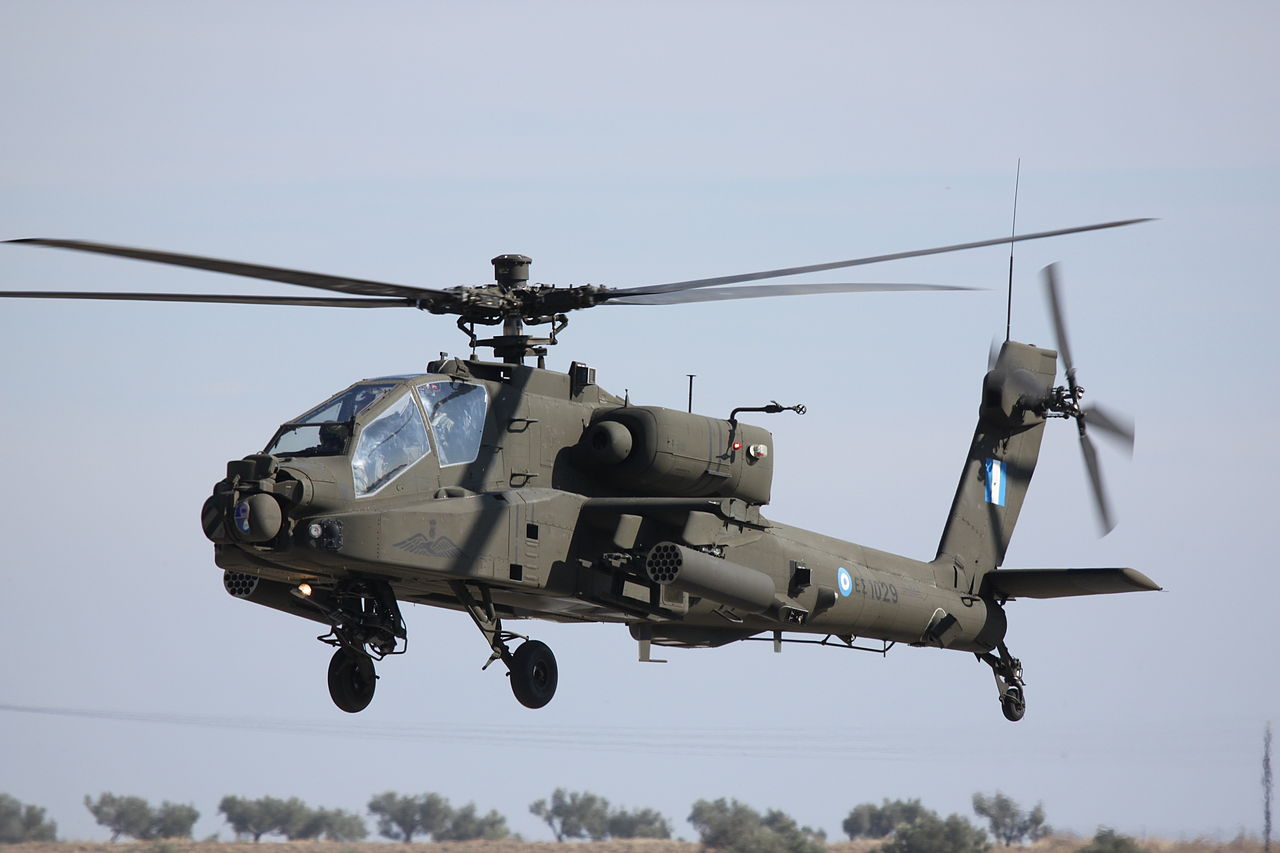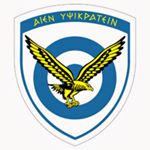Boeing AH-64 Apache. Part #1

Photo of tilted horizon showing helicopter flying above barren land with rectangular patches of green grass. source/credits:Tech. Sgt. Andy Dunaway
The Boeing AH-64 Apache is an American twin-turboshaft attack helicopter with a tailwheel-type landing gear arrangement and a tandem cockpit for a crew of two. It features a nose-mounted sensor suite for target acquisition and night vision systems. It is armed with a 30 mm (1.18 in) M230 chain gun carried between the main landing gear, under the aircraft's forward fuselage, and four hardpoints mounted on stub-wing pylons for carrying armament and stores, typically a mixture of AGM-114 Hellfire missiles and Hydra 70 rocket pods. The AH-64 has significant systems redundancy to improve combat survivability.
The Apache began as the Model 77 developed by Hughes Helicopters for the United States Army's Advanced Attack Helicopter program to replace the AH-1 Cobra. The prototype YAH-64 was first flown on 30 September 1975. The U.S. Army selected the YAH-64 over the Bell YAH-63 in 1976, and later approved full production in 1982. After purchasing Hughes Helicopters in 1984, McDonnell Douglas continued AH-64 production and development. The helicopter was introduced to U.S. Army service in April 1986. The advanced AH-64D Apache Longbow was delivered to the Army in March 1997. Production has been continued by Boeing Defense, Space & Security, with over 2,000 AH-64s being produced by 2013.[3]
The U.S. Army is the primary operator of the AH-64. It has also become the primary attack helicopter of multiple nations, including Hellas , Japan, Israel, the Netherlands, Singapore, and the United Arab Emirates. It has been built under license in the United Kingdom as the AgustaWestland Apache. American AH-64s have served in conflicts in Panama, the Persian Gulf, Kosovo, Afghanistan, and Iraq. Israel used the Apache in its military conflicts in Lebanon and the Gaza Strip. British and Dutch Apaches have seen deployments in wars in Afghanistan and Iraq.
Variants
AH-64A
The AH-64A is the original production attack helicopter. The crew sit in tandem in an armored compartment. It is powered by two GE T700 turboshaft engines. The A-model was equipped with the −701 engine version until 1990 when the engines were switched to the more powerful −701C version.[302]
U.S. Army AH-64As are being converted to AH-64Ds. The service's last AH-64A was taken out of service in July 2012 before conversion at Boeing's facility in Mesa, Arizona.[303] On 25 September 2012, Boeing received a $136.8M contract to remanufacture the last 16 AH-64As into the AH-64D Block II version and this was forecast to be completed by December 2013
AH-64B
In 1991, after Operation Desert Storm, the AH-64B was a proposed upgrade to 254 AH-64As. The upgrade would have included new rotor blades, a Global Positioning System (GPS), improved navigation systems and new radios. U.S. Congress approved $82M to begin the Apache B upgrade. The B program was canceled in 1992.[305] The radio, navigation, and GPS modifications were later installed on most A-model Apaches through other upgrades.
AH-64C
Additional funding from Congress in late 1991 resulted in a program to upgrade AH-64As to an AH-64B+ version. More funding changed the plan to upgrade to AH-64C. The C upgrade would include all changes to be included in the Longbow except for mast-mounted radar and newer −700C engine versions. However, the C designation was dropped after 1993.[306] With AH-64As receiving the newer engine from 1990, the only difference between the C model and the radar-equipped D model was the radar, which could be moved from one aircraft to another; thus the decision was made to simply designate both versions "AH-64D".
AH-64D
The AH-64D Apache Longbow is equipped with a glass cockpit and advanced sensors, the most noticeable of which being the AN/APG-78 Longbow millimeter-wave fire-control radar (FCR) target acquisition system and the Radar Frequency Interferometer (RFI), housed in a dome located above the main rotor.[307][308] The radome's raised position enables target detection while the helicopter is behind obstacles (e.g. terrain, trees or buildings). The AN/APG-78 is capable of simultaneously tracking up to 128 targets and engaging up to 16 at once; an attack can be initiated within 30 seconds.[309][310] A radio modem integrated with the sensor suite allows data to be shared with ground units and other Apaches, allowing them to fire on targets detected by a single helicopter.[311]
The aircraft is powered by a pair of uprated T700-GE-701C engines. The forward fuselage was expanded to accommodate new systems to improve survivability, navigation, and 'tactical internet' communications capabilities. In February 2003, the first Block II Apache was delivered to the U.S. Army, featuring digital communications upgrades. The Japanese Apache AH-64DJP variant is based on the AH-64D;[149] it can be equipped with the AIM-92 Stinger air-to-air missiles for self-defense.
AH-64E
Formerly known as AH-64D Block III, in 2012, it was redesignated as AH-64E Guardian to represent its increased capabilities.[314][315][316] The AH-64E features improved digital connectivity, the Joint Tactical Information Distribution System, more powerful T700-GE-701D engines with upgraded face gear transmission to accommodate more power,[317] capability to control unmanned aerial vehicles (UAVs), full IFR capability, and improved landing gear.[318][319] New composite rotor blades, which successfully completed testing in 2004, increase cruise speed, climb rate, and payload capacity.[320] Deliveries began in November 2011.[321] Full-rate production was approved on 24 October 2012,[322] with 634 AH-64Ds to be upgraded to AH-64E standard and production of 56 new-build AH-64Es to start in 2019/20.[323] Changes in production lots 4 through 6 shall include a cognitive decision aiding system and new self-diagnostic abilities. The updated Longbow radar has an oversea capacity, potentially enabling naval strikes; an AESA radar is under consideration.[324] The E model is to be fit for maritime operations.[325] The Army has expressed a desire to add extended-range fuel tanks to the AH-64E to further increase range and endurance.[138] AH-64Es are to have the L-3 Communications MUM-TX datalink installed in place of two previous counterparts, communicating on C, D, L, and Ku frequency bands to transmit and receive data and video with all Army UAVs.[326] Lots 5 and 6 will be equipped with Link 16 data-links.
AH-64F
In 2014, Boeing conceptualized an Apache upgrade prior to the introduction of the U.S. Army's anticipated attack version of the Future Vertical Lift (FVL) aircraft, forecast to replace the Apache by 2040. The conceptual AH-64F would have greater speed via a new 3,000 shp turboshaft engine from the Improved Turbine Engine Program, retractable landing gear, stub wings to offload lift from the main rotor during cruise, and a tail rotor that can articulate 90 degrees to provide forward thrust.[328] In October 2016, the Army revealed they would not pursue another Apache upgrade to focus on funding FVL; the Army will continue buying the Apache through the 2020s until Boeing's production line ends in 2026, then FVL is slated to come online in 2030.
Operators
- Egyptian Air Force (AH-64D)
- Hellenic Army (AH-64A/D)
- Indian Air Force (AH-64E)
- Indian Army (AH-64E, on order)
- Indonesian Army (AH-64E)
- Israeli Air Force (AH-64A/D)
- Japan Ground Self-Defense Force (AH-64D)
- Kuwait Air Force (AH-64D)
- Royal Netherlands Air Force (AH-64D)
- Qatar Emiri Air Force (AH-64E)
- Royal Saudi Land Forces (AH-64A/D/E)
- Saudi Arabia National Guard (AH-64E)
- Republic of Singapore Air Force (AH-64D)
- Republic of Korea Army (AH-64E)
- Republic of China Army (AH-64E)
- United Arab Emirates Air Force (AH-64D/E)
- See also AgustaWestland Apache
- United States Army (AH-64D/E)

A Hellenic Army AH-64 . source/credits:Jerry Gunner from Lincoln, UK

A AH-64D of Hellenic army avation in flight. souurce/credits:
